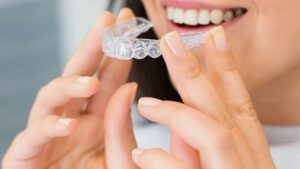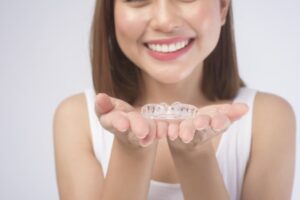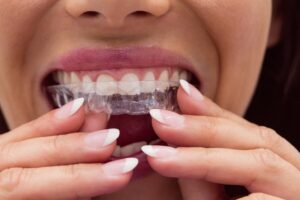If you’re an Invisalign wearer, you would want to maintain the cleanliness of their aligners. Wondering how can you maintain their cleanliness effectively? To get the best of your Invisalign aligners, read on to discover the key dos and don’ts of Invisalign maintenance.
Invisalign is nearly invisible and comes in the form of removable aligners composed of a clear plastic that progressively shifts teeth. Their transparency often leads to neglect in maintenance. It’s crucial to clean them daily to avoid staining and discoloration. Here’s everything you need to know about how to clean Invisalign to maintain your radiant smile.
Importance of Cleaning Your Invisalign
Invisalign stands as a leading orthodontic treatment today. It’s practically invisible, removable, and allows unrestricted eating and seamless brushing and flossing. Despite these advantages, the upkeep can be daunting.
So, does cleaning matter? Absolutely! Even though you swap aligners biweekly, meticulous cleaning remains vital. Worn for 20-22 hours daily, aligners collect plaque and bacteria, risking cavities and gum disease. Build-up might be invisible but it’s there.
Neglecting cleanliness results in yellowing and discoloration, which are hard to reverse. This also contributes to bad breath—an unwelcome addition to anyone’s smile. Maintaining clean aligners is crucial for their longevity and effectiveness.
Five Essential Dos for Cleaning Your Invisalign
The first step of going through Invisalign treatment involves and entails embracing change; particularly in the way a person’s dental care will be handled. Here are five essential practices to keep your Invisalign clean and your breath fresh:
1. Learn How to Clean Invisalign the Cleaning Frequency
Good news: you don’t need to clean your Invisalign more often than you brush your teeth—ideally, twice daily. Clean your aligners every time you brush your teeth. If brushing post-meals isn’t feasible, at least rinse them with water to dislodge food particles.
Rinse with lukewarm water and gently brush with a soft-bristled toothbrush. Avoid hot water which can warp the aligners, and toothpaste which can scratch them. After brushing, rinse thoroughly before reinserting them.
Ensure to brush your teeth before reinserting the aligners. Plaque and bacteria can build up on your teeth when aligners are out, so thorough brushing and flossing are essential.
Regularly clean your Invisalign case. Store aligners in a clean case, washing it with warm water and mild soap weekly.
2. Use Appropriate Cleaners
Opt for cleaners specifically designed for aligners and retainers. Avoid generic store cleaners that may contain harsh chemicals or abrasives.
Many Invisalign providers offer their cleaners, but over-the-counter options are available too. Consult your dentist for recommendations.
- Daily Cleaning: Use clear anti-bacterial unscented soap. Mix a small amount with lukewarm water, brush aligners gently, and rinse thoroughly before reinserting.
- Deep Cleaning: Invisalign Cleaning Crystals effectively removes stains and plaque. Soak aligners in the solution for 20-30 minutes, then rinse.
- Stain Removal: Use a hydrogen peroxide solution (equal parts hydrogen peroxide and lukewarm water). Soak for 15 minutes, then brush and rinse.
- Hard Buildup: Soak in distilled white vinegar solution for 15 minutes before brushing and rinsing. Avoid other vinegars as they can stain aligners.
Invisalign offers a cleaning accessory called Steraligner, which includes a tray and solution with rubbing alcohol and sodium bicarbonate. Soak aligners for 3 minutes, rinse, and brush with warm water.
3. Soak Aligners in Cleaning Crystals Daily
Integrating cleaning crystals into your daily routine proves highly effective. These crystals are adept at eliminating plaque and bacteria, which left unchecked, can lead to oral health issues such as halitosis and gum disease.
Moreover, regular use of cleaning crystals preserves the clarity and extends the lifespan of your aligners, preventing them from becoming dull or yellowed over time. Soak for at least 15 minutes daily, then rinse thoroughly before use.
4. Establish an Oral Hygiene Routine
Despite their nearly invisible nature, Invisalign aligners must be removed during meals and beverages, increasing the propensity for food residues and bacteria to amass on both the aligners and your teeth. Inadequate cleaning can precipitate gum disease, tooth decay, and myriad other dental ailments.
A significant consequence of subpar oral hygiene while wearing Invisalign is malodorous breath. The necessity to remove aligners for eating and drinking heightens the likelihood of food particles becoming ensnared between the aligners and your teeth. If not extricated, these particles will decompose, resulting in an offensive odor.
In severe instances, neglecting oral hygiene with Invisalign can inflict irreversible harm on your teeth. The accumulation of plaque and tartar can erode enamel, which, once damaged, cannot be restored and necessitates expensive dental procedures such as veneers or crowns.
Five Tips to Uphold Excellent Oral Hygiene While Wearing Invisalign
Adhering to these tips will help maintain the cleanliness and transparency of your aligners throughout your treatment.
- Brush and Floss Diligently: Clean your teeth at least twice daily, ensuring you brush and floss before reinserting your aligners post meals or drinks.
- Rinse with Mouthwash: Utilize mouthwash to eliminate any residual bacteria or food debris.
- Daily Soaking: Submerge your aligners in cleaning crystals or employ the Steraligner at least once daily to purge plaque and bacteria from the aligners.
- Restrict Intake to Water: Refrain from consuming anything other than water while wearing your aligners to minimize buildup on your teeth and aligners.
- Regular Dental Visits: Consult your Invisalign dentist regularly for cleanings and check-ups to monitor your oral hygiene and preempt any potential issues.
5. Prepare for Long Trips
For extended trips, it’s crucial to be well-prepared with the necessary tools and supplies to clean your Invisalign aligners. With a bit of foresight, maintaining your oral health while traveling is entirely feasible. Consider the following when preparing for your journey:
- Carry Extra Aligners: Pack additional sets of aligners in case of loss or damage, ensuring your treatment remains uninterrupted.
- Pack Your Retainer Case: Ensure you have your retainer case for storing your aligners when not in use. Keep it in a secure, easily accessible location such as your carry-on bag.
- Bring Dental Wipes: Dental wipes are ideal for on-the-go cleaning, effectively removing food particles and plaque. Keep a few in your purse or bag for convenient use.
- Visit Your Dentist Pre-Departure: Schedule a dental appointment before your trip to have your teeth thoroughly cleaned and checked for any potential issues.
Following these tips will not only help you enjoy your vacation but also ensure you return with healthy teeth.
Five Essential Don’ts for Cleaning Your Invisalign
Avoid these common mistakes to ensure effective Invisalign maintenance:
1. Avoid Eat or Drink with Aligners
Caring for Invisalign aligners also involves some strict measures on the types of food and beverages that can be consumed.
Eating with aligners poses several risks:
- Hard Foods: Can crack or chip aligners. Remove aligners before eating.
- Sticky Foods: Can loosen aligners. Remove aligners before eating.
- Acidic Foods: Can erode aligners. Remove aligners or brush teeth before reinserting.
Drinking with aligners can also cause issues:
- Sugary Drinks: Promote bacteria and plaque buildup, leading to decay.
- Hot Beverages: Can warp aligners. Let them cool or remove aligners.
- Alcohol: Can stain and dry out aligners. Remove aligners before drinking.
2. Avoid Use Abrasive Cleaners
Invisalign aligners are made of plastic and should be handled gently. To protect your investment in Invisalign aligners, it’s crucial to avoid abrasive cleaners that could harm the aligner material. Harsh chemicals, abrasive toothpaste, and hot water should be substituted with gentle cleaning solutions like mild soap and lukewarm water. These precautions ensure that your aligners remain intact and effective throughout your treatment journey.
- Harsh Chemicals: Avoid bleach, baking soda, or alcohol. Use gentle soap and water.
- Abrasive Materials: Avoid gritty toothpaste or hard-bristled brushes. Use soft bristles and mild soap.
- Hot Water: Can warp aligners. Use lukewarm water.
- Bleach: Avoid bleach or products containing bleach.
- Soaps with Dyes: Can stain aligners. Use clear, mild soaps.
3. Protect Your Aligners
Maintaining the pristine condition of your Invisalign aligners is paramount, yet equally crucial is their proper storage. Exposing your aligners to the ambient air can lead to desiccation, rendering them fragile and prone to fractures. Should your aligners succumb to damage, the financial burden of replacements and the potential delay in your orthodontic regimen could be significant.
Furthermore, Invisalign trays left unattended are vulnerable to accumulating dust, grime, and other particulates. This not only detracts from their appearance but also poses a risk of infection if they are not meticulously sanitized before reinsertion. Additionally, the risk of misplacement is ever-present; numerous patients have recounted frantic searches for their elusive trays. To avert such stress, ensure your aligners are consistently housed in their designated case when not in use.
As an Invisalign patient, the longevity and efficacy of your aligners hinge on diligent care. This encompasses regular cleaning and secure storage. Resist the inclination to leave your Invisalign tray on any surface; instead, place it back in its protective case.
- Maintenance of Your Aligner Case
The hygiene of your Invisalign case is intrinsically linked to the cleanliness of your aligners and, consequently, your oral health. Aligners, worn for approximately 22 hours daily, are in constant contact with saliva, a medium teeming with bacteria. Neglecting the cleanliness of your aligner case can result in bacterial transfer, leading to discoloration and unpleasant odors.
Beyond aesthetics, bacterial proliferation on your aligners can precipitate gum disease and other oral maladies. Hence, it is imperative to maintain a scrupulously clean aligner case. A contaminated case could undermine the benefits of your Invisalign treatment.
Moreover, mold can thrive in an improperly dried case, further underscoring the necessity of thorough cleaning. The optimal method involves rinsing the case with warm water, applying a few drops of antibacterial soap, and ensuring a complete rinse. It is crucial to dry the case thoroughly before reinserting your aligners. Additionally, weekly sanitation with a disinfectant is advisable, ensuring the case is completely cool before use.
5. Refrain from Smoking is a Vital Advisory
Smoking is detrimental to overall health and particularly adverse for Invisalign users. It exacerbates the risk of gum disease, tooth loss, and stains teeth, compounding the effects on your Invisalign aligners.
Nicotine and tar from cigarettes can discolor aligners, defeating the purpose of having virtually invisible orthodontic devices. Even passive exposure to smoke can lead to discoloration. Stained aligners can be cleaned with toothpaste and water or soaked in denture cleaner overnight to mitigate staining.
Smoking is a significant contributor to gum disease, an infection that causes gum inflammation, bleeding, and tooth loss. Prompt treatment by a dental professional is essential to manage gum disease and safeguard your Invisalign treatment. Regular dental visits are crucial for early detection and management of gum disease.
Smoking also impedes the body’s healing processes, potentially prolonging recovery from dental procedures. This can delay the overall timeline of your Invisalign treatment. Thus, abstaining from smoking, or at least reducing it significantly, is advisable to avoid treatment delays.
Conclusion
Maintaining impeccable oral hygiene is pivotal for the success of your Invisalign treatment. Regular cleaning of both aligners and their case is essential. Invisalign offers an innovative method for teeth alignment without traditional braces. However, understanding the dos and don’ts of how to clean Invisalign ensures their optimal condition and efficacy throughout your treatment.







